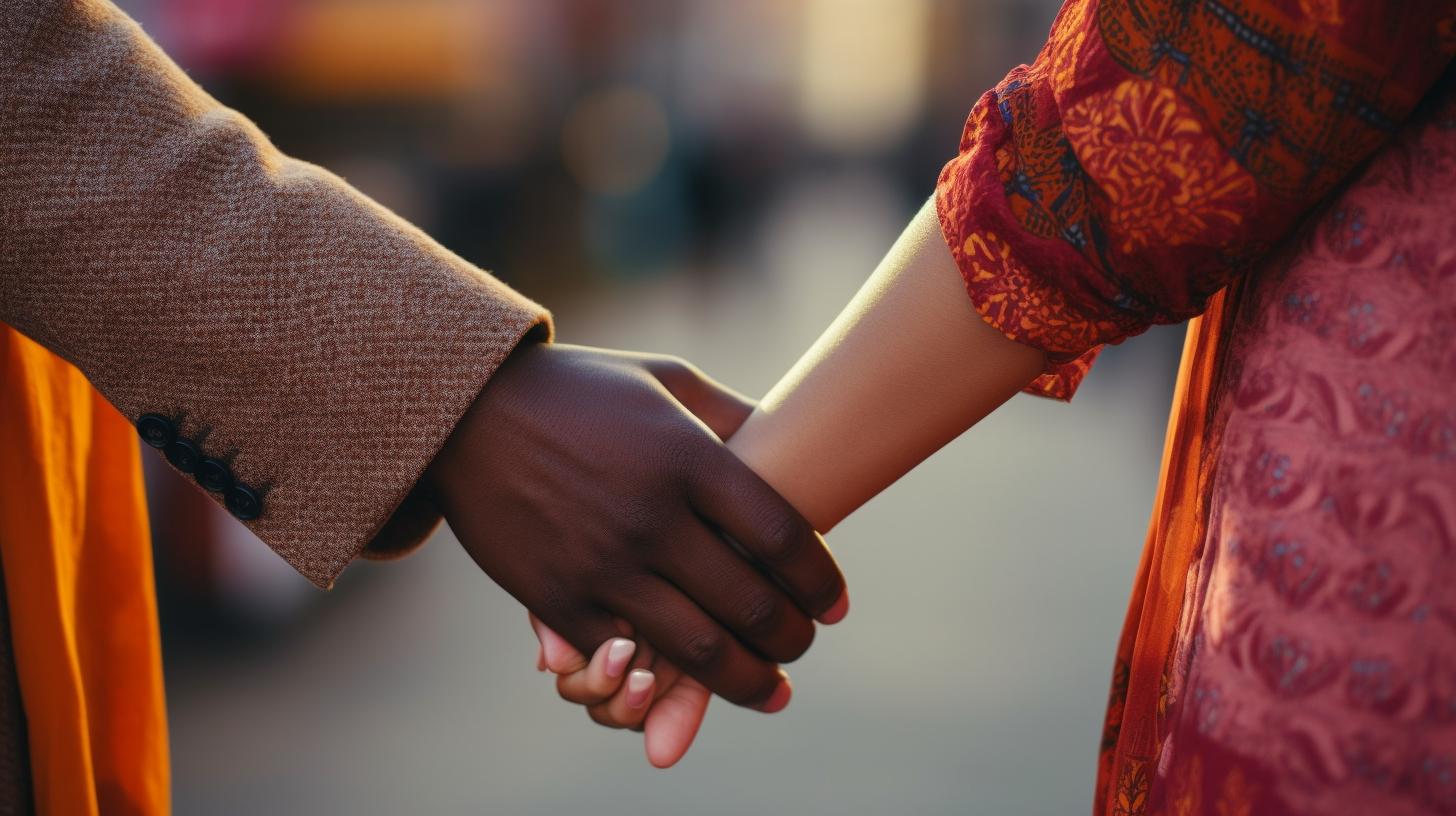Do you ever wonder why the ways people express affection differ so much across cultures? If you’re dating someone from a different culture, you may find that their expressions of love and affection are different from what you’re used to. In this article, we will explore cultural expressions of affection in different cultures and provide guidance for those engaging in multicultural dating.
What are Cultural Expressions of Affection?
Cultural expressions of affection refer to the ways people in different cultures express love and affection towards their romantic partners, family members, and friends. These expressions can include physical touch, verbal expressions, non-verbal expressions, and public displays of affection.
Cultural Expressions of Love in Different Cultures: A Multicultural Dating Guide
- Physical touch and verbal expressions of affection vary widely across cultures, affecting multicultural dating.
- Cultural norms and values play a significant role in shaping how people express love and affection.
- Non-verbal expressions of affection also vary across cultures, and effective communication is crucial for building understanding and respect in multicultural dating.

Physical Touch as a Cultural Expression of Affection
Physical touch is a fundamental aspect of expressing affection in many cultures. However, the type of touch and degree of intimacy considered appropriate can vary widely. For example, in some cultures, such as France, it is common to greet someone with a kiss on the cheek. In contrast, physical touch in public is generally frowned upon in Japan. A study on affectionate touch across cultures found that diverse and intimate touch is universally important in close relationships, but the amount of affectionate touch varies between countries due to factors such as climate, conservatism, religiosity, age, gender, and liberalism [1].
These differences in physical touch can be particularly challenging in multicultural dating. It is essential to communicate openly and respectfully about physical touch preferences and boundaries to avoid misunderstandings and discomfort.

Verbal Expressions of Affection
Verbal expressions of affection can also vary widely between cultures. For example, in some cultures, it is common to express love and affection through words such as “I love you” or “I adore you,” whereas in others, such expressions are reserved for more intimate relationships. In some cultures, such as Japan, expressing love verbally is considered somewhat taboo, and people may instead express their affection through actions rather than words.
Understanding these differences in verbal expressions of affection is vital in multicultural dating. It is essential to understand and respect your partner’s cultural background and their preferences regarding verbal expressions of affection.
Cultural Norms and Values Affecting Expressions of Affection
Cultural norms and values play a significant role in shaping how people express love and affection. For example, in some cultures, such as China, the public expression of love towards a spouse or romantic partner has long been discouraged, whereas in others, such as the United States, public displays of affection are more common [2].
These cultural differences can be particularly challenging in multicultural dating. It is essential to understand and respect your partner’s cultural background and their preferences regarding the public expression of affection.

Non-Verbal Expressions of Affection
Non-verbal expressions of affection are another aspect of cultural expressions of love. For example, in some cultures, such as Italy, physical touch is an essential part of expressing affection, while in others, such as Japan, non-verbal expressions of affection, such as giving gifts or doing kind deeds, may be more common.
Understanding these differences in non-verbal expressions of affection is crucial in multicultural dating. It is essential to communicate openly and respectfully about your partner’s non-verbal expressions of affection and to recognize that they may express their affection in ways that are different from your own.

Communication and Understanding in Multicultural Dating
Clear and effective communication is crucial for anyone engaging in multicultural dating. It is essential to approach these relationships with an open mind, a willingness to learn, and a deep respect for your partner’s cultural background. Communication should be open, honest, and respectful, with a focus on building understanding and respect. It is also important to recognize that misunderstandings and differences may arise, but with patience, empathy, and a willingness to learn, these challenges can be overcome.
Case Study: Navigating Physical Touch in a Multicultural Relationship
When I started dating my partner, Juan, I quickly realized that physical touch was very important to him. Coming from a culture where touch is used to express emotions and bond with others, Juan was used to hugging, kissing, and holding hands in public. As someone from a culture where physical touch is reserved for close family and romantic partners, I found this challenging at first.
I remember feeling uncomfortable with how much Juan wanted to touch me in public, and I worried about how others might perceive us. However, I soon realized that this was a fundamental part of who Juan was and that I needed to understand and respect his cultural background.
We had many conversations about physical touch and how it differed in our respective cultures. I shared my perspective on touch, and Juan explained how touch was used in his family and community. Through these conversations, we developed a mutual understanding and respect for each other’s cultural expressions of love and affection.
Now, I feel much more comfortable with public displays of affection, and Juan is more aware of my personal boundaries and comfort levels. Our relationship has grown stronger as we continue to learn from each other and navigate the complexities of multicultural dating.

Challenges in Multicultural Dating
Multicultural dating can be challenging due to differences in cultural expressions of affection. For example, misunderstandings may arise due to differences in physical touch, verbal expressions of affection, and non-verbal expressions of affection. It is also common for people to experience anxiety or discomfort when engaging in multicultural dating due to differences in cultural values and norms.
To overcome these challenges, it is essential to approach multicultural dating with an open mind, a willingness to learn, and a deep respect for your partner’s cultural background. Communication should be open, honest, and respectful, with a focus on building understanding and respect. It may also be helpful to seek guidance from a multicultural therapist or counselor who can provide additional support and guidance.
Conclusion
Understanding cultural expressions of affection is vital for anyone engaging in multicultural dating. By approaching multicultural dating with an open mind, a willingness to learn, and a deep respect for your partner’s cultural background, people can build strong and meaningful relationships across cultures.
Insider Tips
“When engaging in multicultural dating, be open and willing to learn about your partner’s cultural background. This can help you better understand their expressions of affection and build a stronger, more meaningful relationship.”
“Remember that cultural differences can lead to misunderstandings, but with patience, empathy, and a willingness to learn, these challenges can be overcome.”
“Communication is key in multicultural dating. Be open and honest about your preferences and boundaries regarding physical touch, verbal expressions of affection, and non-verbal expressions of affection.”
FAQ
Q: What are some examples of cultural expressions of affection?
A: Examples of cultural expressions of affection include physical touch, verbal expressions of affection, non-verbal expressions of affection, and public displays of affection.
Q: Why is it important to understand cultural expressions of affection in multicultural dating?
A: Understanding cultural expressions of affection is crucial for building cultural competence, promoting inclusivity, and developing meaningful connections in multicultural dating. It can also help avoid misunderstandings and discomfort.
Q: What are some challenges in multicultural dating?
A: Challenges in multicultural dating include differences in cultural expressions of affection, anxiety or discomfort due to differences in cultural values and norms, and misunderstandings that may arise due to cultural differences.
References
- Expression of Affection Through Touch Across Cultures
- Affectionate Communication Across Cultures: A Comparison of American and Chinese TV Programs and Books
| Culture | Physical Touch | Verbal Expressions of Affection | Non-Verbal Expressions of Affection | Public Displays of Affection |
|---|---|---|---|---|
| France | Greeting with a kiss on the cheek | “Je t’aime” (I love you) | Physical touch | More common |
| Japan | Physical touch in public is generally frowned upon | Expressing love verbally is considered somewhat taboo, and people may instead express their affection through actions rather than words | Giving gifts or doing kind deeds | Discouraged |
| Italy | Physical touch is an essential part of expressing affection | “Ti amo” (I love you) | Physical touch | More common |
| China | Public expression of love towards a spouse or romantic partner has long been discouraged | Reserved for more intimate relationships | Red envelopes with money | Discouraged |
| United States | Hugging and kissing on the cheek | “I love you” | Physical touch | More common |




